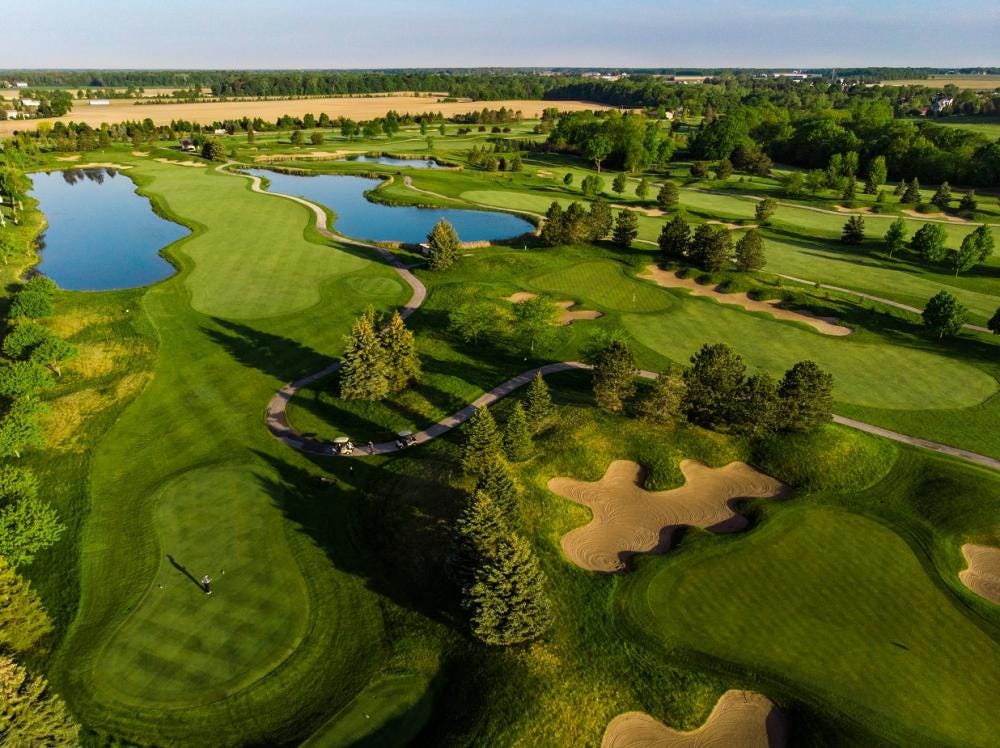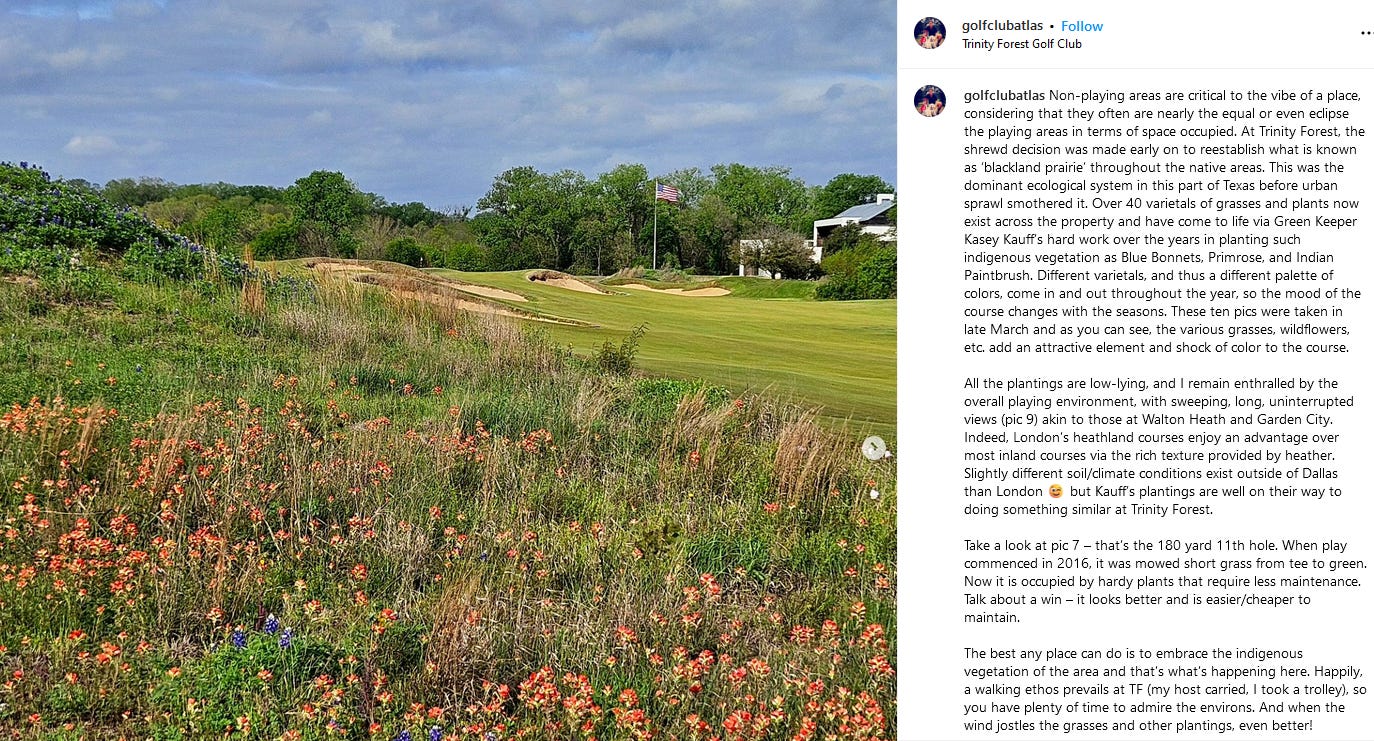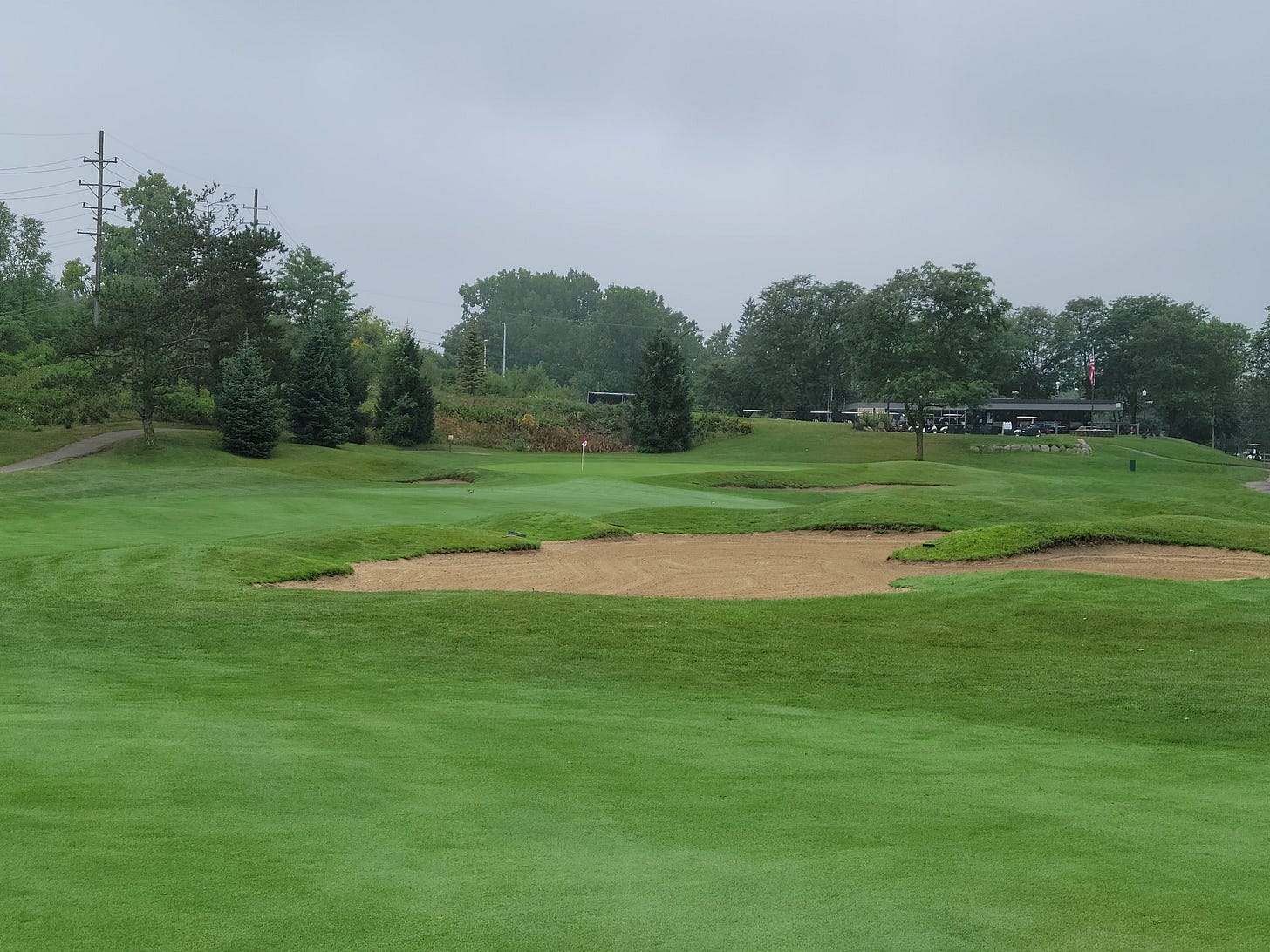Arcadia Update - The Dozen

Last week’s rumor was that Arcadia Bluffs was building a short course, but I didn’t have much in the way of details at the time. Since then, several people have reached out to me with information and at least one official document, so we have a lot more concrete details to go off of now. The things I know are listed below. The only news that hasn’t surfaced at this point, as far as I know, is who is designing and building the course.
The course will be named The Dozen*, and will consist 12 holes that are a mix of par 4’s and par 3’s.
A putting course is likely to be included.
A clubhouse and pro shop will be on the grounds, and food will be available for golfers, although no dinner service.
Four cottages will be on the grounds, with potentially four more added in the future.
Trees were cleared from the site in fall of 2023, and they started moving dirt probably around March 2024. No new aerial imagery of either, yet.
No opening date has been established, but it’s likely to be Spring 2025.
Depending on where the entrance is located, my estimate on distance between the Bluffs entrance and the Dozen entrance is around 0.75 miles.
* The name reminds me of The Dozens, and I laugh to myself every time I think about golfers wandering the grounds of Arcadia Bluffs telling “yo mama” jokes.
Tri-city golf and Apple Mountain
To continue the discussion from a few weeks ago about golf in the tri-cities, I neglected to mention another option in Freeland, Apple Mountain. Before I was even old enough to drive, working the bag drop here was possibly the first real job I ever had. The course was still quite new at the time, and had gotten a brief feature in Golf Digest (or one of the magazines) and the article was framed in the pro shop. Not knowing any better, I thought the course might have been one of the best in the state.
To add to the prestige, for a period from 1997-2001 the Detroit Lions held their training camp at nearby Saginaw Valley State, and in their downtime some players would come by to play the course. We got to carry their bags, wash their clubs, and pepper them with a million annoying questions. The only player I distinctly remember talking to was Mark Carrier, and asking him if he had played Medinah no. 3, for reasons that are completely lost to me.
Anyways, the point of this is to say that in relation to my idea for something new at Twin Oaks (from Loop Links, no. 10), what I would not want to see is something akin to Apple Mountain, or the other upscale public course in the region, The Fortress in Frankenmuth. By this I mean turning the water hazards into main features of the course, adding bubbly-looking bunkers throughout the property, turning the speed up on the greens, and offering $80-$100 rates to play it. For one, this has already been done with the aforementioned courses. Secondly, as nice as it is for a golf-starved region like the tri-cities to have those two options, you can find very similar types of courses throughout the state. Adding a third such course in close proximity will not draw visitors to the region.
If you did something different, however, something bold and not widely available in the state or even the greater Great Lakes area, such as a public Raynor-style course, then all of a sudden you have a draw for visitors. And when people visit from more than a few hours’ radius away, then they need a place to stay. And if they are going to stay, they will want to play more golf. So in essence… you’re welcome Apple Mountain and Fortress!
Additionally, do you know what is a centrally located resort hotel that offers golf, and could greatly benefit if they ever got their act together? Bay Valley. For starters, they could build the putting course that I advocated for in Loop Links, no. 1 in the large area of wasted space in front of their hotel.
Green Space and Golf
I came across an Instagram post recently by Ran Morrisett of Golf Club Atlas, discussing the non-playing areas at Trinity Forest Golf Club. If you remember, Trinity Forest is a Coore & Crenshaw design that was built just outside of Dallas on top of a former landfill, and had a brief stint at hosting the Byron Nelson event on the PGA Tour. Due to the landfill underneath the course, trees with deep roots could not be added to the property without penetrating the sealed landfill below, much to the chagrin of both fans and players at the Byron Nelson event who complained about the relentless sun beating down on them.
You can read about the details in the post below (hopefully it’s not too small, otherwise click on it to go to the post on IG), but essentially it talks about restoring native “blackland prairie” to the site, which covered much of the Dallas area prior to urbanization. The upshot is that not only does it enhance the golf experience, but it also helps revitalize indigenous vegetation that likely would no longer exist if the golf course were not present.
Tying this back to Michigan golf, as I am wont to do, I couldn’t help but be reminded of something that got me fired up a few months back. The Ann Arbor city council, upon voting on whether or not to renew a lease on gas-powered golf carts for the two municipal golf courses in the city, Leslie Park and Huron Hills, brought up the idea of closing the courses outright. The thought process was that operating gas-powered carts, which go a long ways towards helping the courses make money, went against the environmental goals of the city, and many of the environmentally-minded (yet non-golfing) members of the council believe that there are better uses for the land, with housing being a high priority on the list*.
I had a discussion about this idea with a local parent who is actually a casual golfer, but much more hardcore about environmentalism and addressing housing shortages, and we did not see eye to eye on the benefits or need for municipal golf in the city. I don’t know if I laid out my best argument while put on the spot over several drinks, so I will use this space to clear the air.
I’m going to start with a forum post I found on the subject. Unfortunately I can’t remember where I found this, but the points were so good that I copied them down. I’ll add a few more points of my own at the end.
Golf courses are a lazy and easy target for people. In a lot of urban and suburban areas in the US, golf courses that aren't making money are already being sold and having the same large housing developments with no density built on them. Attacking golf courses when there are giant parking lots and inefficient land use everywhere around is dumb.
Just because people don't golf doesn't mean the course isn't a benefit to their area. Most city and metroparks-owned courses help fund or completely fund some of the other parks (GLL Note: Leslie Park is one of only three green spaces in Ann Arbor that turns a profit). This helps to keep taxes lower for the people who live there as it makes the parks department more self-sufficient. Each golf course also adds 50-100 jobs to people locally, and are one of the best summer jobs for kids in school. They also provide the ONLY large green spaces in most areas. Even if you don't golf, you get the benefit of flood reduction, temperature reduction, more wildlife, and the mental benefits of a large green space to walk/bike/drive by. Golf courses also get much better at resource usage every year because it saves them money on their biggest expense.
Also, it shows people don't even know what they're talking about (GLL Note: Referring to the idea of golf as an elitist activity). Go to a public urban golf course and see who is actually playing there. It's not rich people, I can tell you that. They're cheap gathering places for people of all races, ages, and genders. For many senior citizens, going to the driving range or their golf league for a few hours is their social life. They hangout with friends and strangers for a few hours, and hit golf balls maybe a third of the time they're there. First tee programs across the country allow kids living in poverty to experience playing a game while walking outdoors. For many, it's their only experience walking in nature. Most people who golf are middle/lower class. Just because the wealthy golfers make the sport seem stuffy and exclusive doesn't mean it actually is outside of their private clubs.
It also drives away a lot of average people from getting involved in better urban planning because it's just a dumb fight that feeds into the negative connotations they hear from facebook or news sources about improving cities. What's next? Eliminate all baseball and soccer fields? No more tennis and basketball courts? Remove all swimming pools because they use a lot of water?
To support these points, especially about the benefits of the golf course to non-golfers, the Huron Hills course sits in a floodplain, and last year was awarded the American Society of Civil Engineers “Michigan Section Quality of Life Award" for recent work to improve Benz Creek, which flows through course. Read the article, it details all of the different benefits of the Benz Creek project. But if you want the TL;DR version, it’s basically this:
The goals of this project were to fix flooding issues and improve water quality. The unique design addressed the flooding problem while adding features that improved wetland habitat and flood conveyance capacity. These developments enhanced the design and playability while reducing rain shut down events on the golf course.
The cost of the project was around $1.22 million, and achieved goals that simply would not be possible were the course turned into housing, or would come at a much greater cost were the course turned into non-golf green space, as some have advocated for. As I detailed in Loop Links, no. 4, simply turning a closed golf course into green space is an illusion. A diverse green space with native vegetation and usable park land for visitors requires an immense investment to create, along with maintenance costs. Spaces don’t just “re-wild” into an attractive public asset on their own, but they do turn into a field of weeds on their own. And remember, in the case of Leslie Park, you would be looking at replacing a community green space that actually turns a profit, and which already contains native vegetation and a butterfly sanctuary.
With that said, there are certainly issues that need to be addressed. Reliance on gas-powered carts**, let alone reliance on carts to turn a profit, is a problem. As is the practice of a municipal golf course only being of use to golfers, particularly adult golfers, for traditional 9- or 18-hole rounds (Huron Hills is a little more geared towards families and beginners than Leslie Park is). Could the courses be used in other ways that involve more of the community, much like the town of St. Andrews takes over the Old Course every Sunday as a public park?
In the example of St. Andrews, the town fiercely defends their golf course, and views it as a vital part of the community (and not just for the tourist money coming in). How could this embrace of muni courses become a reality in Michigan?
It’s a major conversation to be had, for sure, but here are some general ideas. Try to move golfers away from carts and towards walking. That comes with a loss of cart revenue, sure, but it promotes a healthier community and is better environmentally. Find ways to utilize the golf space in new ways to attract young golfers and casual golfers - short loops, putting courses, camps, special events, things of that nature. Look for ways to involve the community of non-golfers, such as implementing programs for the Leslie Science Center or local STEM programs to learn about course maintenance or the butterfly sanctuary, similar to an idea presented by golf course architect Andy Staples involving the First Green program. Take advantage of the course space for community events, such as something like what Canal Shores in Evanston, IL does with the Out of Space concert series.

I’m just skimming the surface here with these ideas, and a deeper dive could reveal any number of creative ways that municipal courses can be assets to the entire community, not just to adult golfers. The point is, theses courses need to be proactive with their solutions before the city council and non-golfing public come for them. Golf courses can easily be turned into housing, but housing can’t easily (or can’t ever, more realistically) be turned back into green space of any kind.






